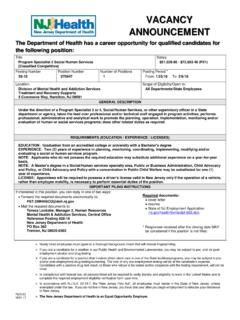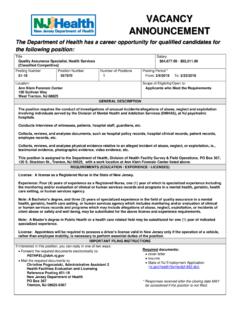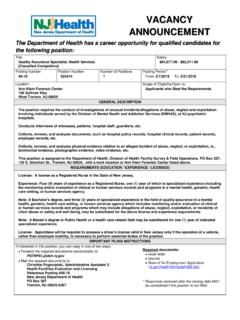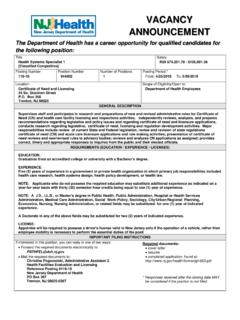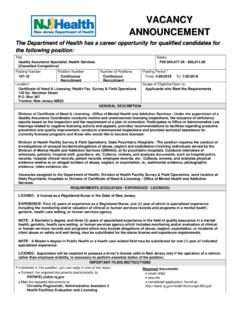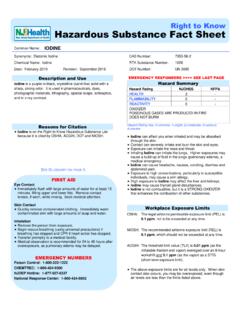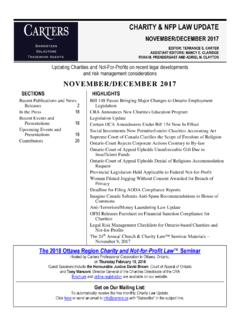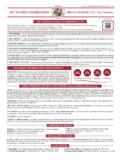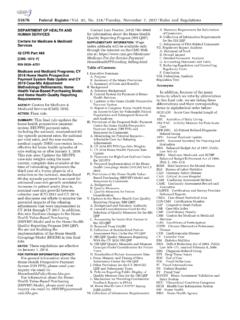Transcription of 50 NJR 1(2) January 16, 2018 Filed December 22, …
1 50 NJR 1(2) January 16, 2018 Filed December 22, 2017 HEALTH HEALTH SYSTEMS BRANCH DIVISION OF CERTIFICATE OF NEED AND LICENSING OFFICE OF CERTIFICATE OF NEED AND HEALTHCARE FACILITY LICENSURE Hospital Licensing Standards Infection Control: Sepsis Protocols Adopted New Rule: 8 Proposed: June 19, 2017 , at 49 1653(a). Adopted: November 6, 2017 , by Cathleen D. Bennett, Commissioner, Department of Health (with the approval of the Health Care Administration Board). Filed : December 19, 2017 , as , with non-substantial changes not requiring additional public notice and comment (see 1 ). Authority: 26:2H-1 et seq., particularly 26:2H-5 and Effective Date: January 16, 2018. Expiration Date: December 18, 2024. Summary of Public Comments and Agency Responses: The Department received comments from the following: 1.
2 Sean Benson, Vice President and General Manager, Specialized Surveillance, Wolters Kluwer Health, Minneapolis, Minnesota; 2. Michele Garcia, Association for Professionals in Infection Control and Epidemiology, Inc., of Southern New Jersey, Chapter 11, Marlton, NJ; 3. Thomas Heymann, Executive Director, Sepsis Alliance, Maplewood, NJ; 2 4. Aline M. Holmes, DNP, RN, Senior Vice President, Clinical Affairs, New Jersey Hospital Association (NJHA), Princeton, NJ; 5. Sarah Lechner, Vice President, Policy Development and Government Affairs, RWJB arnabas Health, West Orange, NJ; 6. Melinda R. Martinson, General Counsel, Medical Society of New Jersey, Lawrenceville, NJ; 7. Sharon Parrillo, BSN, RN, CIC, and 2017 President of the Association for Professionals in Infection Control and Epidemiology, Inc.
3 , of Northern New Jersey; 8. Linda Schwimmer, JD, President and CEO, New Jersey Health Care Quality Institute, Princeton, NJ; 9. Ann Twomey, President, Health Professionals and Allied Employees, AFT/AFL-CIO, Emerson, NJ; 10. K. Gilbert, Summit, NJ; and 11. Jessica Aubry, Blackwood, NJ Joshua Bartell, Blackwood, NJ Lisa Bartlett Davis, Sepsis Alliance, Colorado Springs, CO Linda Brennan, Yonkers, NY Linda Brennan, Rory Staunton Foundation, New York, NY Jaimie Cramer, Hammonton, NJ Rose Culliney, Sewell, NJ Cynthia DeMonte, Astoria, NY Kimberly Edwards-Wunderlich, Pelham, NH Geraldine Endicott, Mount Laurel, NJ 3 Susanna Fitzgerald, South Bound Brook, NJ William Fitzgerald, South Bound Brook, NJ Deb Kelly Ellen Labanowski, Cranford, NJ Maryellen Magee, Marlton, NJ Sandra Mclean, Blackwood, NJ Eileen McMahon, Spring Lake, NJ Megan Mortillite, Williamstown, NJ Tara Nadzadi, Gibbstown, NJ Sherita Nzali, Berlin, NJ Celestial Piedra, Avenel, NJ Justina Piedra, Avenel, NJ Nick Purcell, East Windsor, NJ Patricia Purcell, East Windsor.
4 NJ Jacqui Snype, Athleague, Roscommon, Ireland Randee Speece, Cedarbrook, NJ Randee Speece, West Berlin, NJ Holly Streeter, Sewell, NJ Harold Tamke, Matawan, NJ Brittany Taylor, Williamstown, NJ Dylan Taylor, Sewell, NJ Freddy Taylor, Sewell, NJ Frederick Taylor, Sewell, NJ 4 Frederick Taylor, Jr., Sewell, NJ Nicole Taylor, Blackwood, NJ Nicole Taylor, Williamstown, NJ Terry Taylor, Sewell, NJ Theresa Taylor, Sewell, NJ Elizabeth Therrien, Tulsa, OK Danielle Z, West Deptford, NJ Quoted, summarized, and/or paraphrased below, are the comments and the Department s responses. The numbers in parentheses following the comments below correspond to the commenter numbers above. 1. COMMENT: A commenter expresses strong support for New Jersey s proposed rule revising the [State s] hospital licensing standards to include new evidence-based protocols to identify and treat cases of sepsis and applaud[s] New Jersey s leadership in taking steps to improve sepsis detection and treatment in hospitals, and release of the proposed new rule is timely.
5 A report released just last month by the Agency for Health Research and Quality .. found that cases of sepsis in hospitals tripled between 2005 [through] 2014. An earlier study presented at the American Thoracic Society s annual conference in May 2014 concluded that sepsis contributes close to half of all hospital deaths in the United States. Early detection and quick treatment for sepsis in the hospital setting is particularly important to prevent complications and hospital readmissions. A 2015 study published in the American Journal of Respiratory and Critical Care Medicine found that older adults are three times more likely to develop sepsis in the first three months after leaving a hospital than at 5 any other time, and that the risk of sepsis is 30 [percent] higher for patients whose original hospital stay involved care for infections such as pneumonia.
6 And a research letter published in February of this year in the Journal of the American Medical Association concluded that sepsis is associated with more hospital readmissions than myocardial infarction and heart failure. Requiring hospitals to establish, implement[,] and periodically update evidence-based protocols for the early identification and treatment of patients with sepsis has shown to be a particularly effective strategy to lower the number of inpatient deaths. [The States] of New York and Illinois both adopted similar protocols in 2013 and 2016, respectively. A recent study published in the New England Journal of Medicine concluded that the use of such protocols in New York hospitals was associated with lower risk-adjusted in-hospital mortality. (1) 2. COMMENT: A commenter is in alignment with the aims of the proposed new rule.
7 Which seeks to protect patients from the dangers of sepsis through assuring effective protocols for its early identification and treatment. (2) 3. COMMENT: A commenter welcomes and applauds the .. commitment [of the Department] to saving lives and preventing serious injury from sepsis. The commenter also [recognizes] the tremendous work already done in the [State] by the New Jersey Hospital Association[, which] has achieved an 11 [percent] reduction in sepsis mortality and generated impressive increases in the use of hospital-wide screening tools and adoption of hospital-wide sepsis protocols. The challenge will be to secure 100 [percent] participation across the [State], provide necessary resources and support to ensure that [New Jersey] hospitals can enjoy sustainable success, ensure that new [rule does] not create unintended negative consequences, and make the 6 [State s] residents aware of sepsis as a medical emergency so they know to seek treatment as early as possible (a critical component for successful sepsis treatment).
8 The commenter supports the promulgation of 8 that would require [New Jersey] hospitals to institute a sepsis protocol and require training of hospital personnel among other This rule is an important step toward leveraging the good work that has been done already to make sepsis a rare cause of death and disability in .. New Jersey. [The commenter] looks forward to working with the [Department], the New Jersey Hospital Association, New Jersey s hospitals, [State]-wide community leaders, and the .. public to ensure that New Jersey becomes a national leader in sepsis prevention, early identification[,] and treatment. (3) 4. COMMENT: A commenter states, Over the past two and a half years, [the] NJHA and its Institute for Quality and Patient Safety, have led the New Jersey Sepsis Learning Action Collaborative (the Collaborative) to a 13 percent decrease in [Statewide] sepsis mortality by providing support to hospitals in the assessment, design and implementation of comprehensive practices that allow for both early sepsis identification and rapid treatment of septic patients.
9 Through the Collaborative s efforts, [the] NJHA has and will continue to: [(1)] Provide acute and post-acute healthcare organizations with updates on evidence-based guidelines and strategies to identify and manage sepsis in both adult and pediatric populations; [(2)] Consult with subject matter experts in the field of sepsis and critical care medicine to create education and training opportunities for clinicians; 7 [(3)] Measure, monitor and provide [State]- and hospital-level feedback reports for sepsis mortality and associated outcomes ([that is,] sepsis-related readmissions); and [(4)] Engage patients and families in a better understanding of sepsis-related harm and prevention efforts. The commenter supports the .. proposed rule that would require hospitals to establish, implement[,] and periodically update evidence-based sepsis protocols for the early identification and treatment of patients in various levels of sepsis (sepsis and septic shock) and to train staff with clinical responsibilities in the sepsis protocols.
10 The commenter also supports the [Department s] recommendation to allow hospitals to develop their own protocols based on current national and international best practices, rather than mandating a strict protocol for all facilities to follow. This is especially important because of the ever-evolving research on the care of patients with sepsis, here in the United States and internationally. Hospitals must be allowed to adjust their protocols as needed based on the most current evidence at that time, rather than be locked into a protocol that may quickly become outdated. (4) 5. COMMENT: A commenter appreciates the Department s continuing efforts to improve patient safety and encourage collaboration within the (5) 6. COMMENT: A commenter recognizes the success of [the NJHA s] Institute for Quality [and] Patient Safety and the Surviving Sepsis Campaign s 2015 Sepsis Learning Action Collaborative [and] fully supports the.
